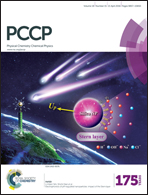Electrochemical properties of a thermally expanded magnetic graphene composite with a conductive polymer†
Abstract
A magnetic graphene composite derived from stage-1 FeCl3–graphite intercalation compounds was thermally treated for up to 75 min at 400 °C or for 2 min at high temperatures up to 900 °C. These heat-treatments of the magnetic graphene composite gave rise to the cubical expansion of graphene with the enlargement of inter-graphene distances. The specific capacitance of the magnetic graphene composite increased upon heating and reached 42 F g−1 at a scan rate of 5 mV s−1 in 1.0 M NaCl, after being treated for 2 min at 900 °C. This value corresponds to 840% increase in the capacitance activity superior to that (5 F g−1) of the pristine magnetic graphene composite before heat-treatment. This capacitance enhancement can play a significant role in the increase of the surface area that reached 17.2 m2 g−1 during the non-defective inter-graphene exfoliation. Moreover, the magnetic graphene composite heated at 900 °C was hybridized with polyaniline by in situ polymerization of aniline to reach a specific capacitance of 253 F g−1 at 5 mV s−1. The current procedure of heat-treatment and hybridization with a conductive polymer can be an effective method for attaining a well-expanded magnetic graphene composite possessing an enhanced electrochemical activity with a relatively high energy density (141 W h kg−1 in 1.0 M NaCl) and an excellent stability (99% after 9000 cycles of 20 A g−1).


 Please wait while we load your content...
Please wait while we load your content...